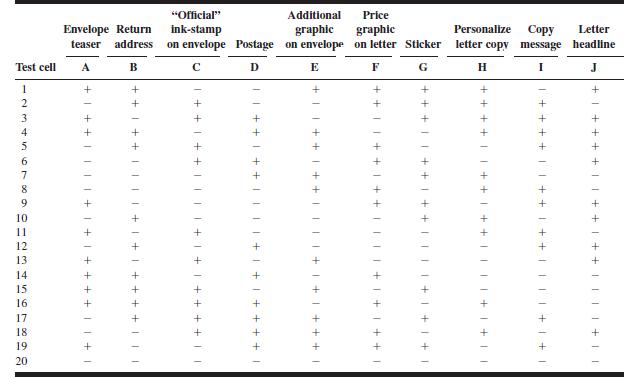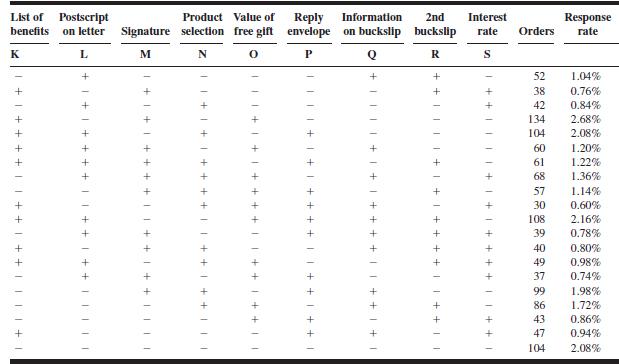8.38. An article in the International Journal of Research in Marketing (Experimental design on the front lines
Question:
8.38. An article in the International Journal of Research in Marketing (“Experimental design on the front lines of marketing:
Testing new ideas to increase direct mail sales,” 2006, Vol. 23, pp. 309–319) describes the use of a 20-run Plackett–Burman design to investigate the effects of 19 factors to improve the response rate to a direct mail sales campaign to attract new customers to a credit card. The 19 factors are as follows:

The 20-run Plackett–Burman design is shown in Table P8.10.
Each test combination in Table P8.17 was mailed to 5,000 potential customers, and the response rate is the percentage of customers who responded positively to the offer.
(a) Verify that in this design each main effect is aliased with all two-factor interactions except those that involve that main effect. That is, in the 19 factor design, the main effect for each factor is aliased with all two-factor interactions involving the other 18 factors, or 153 two-factor interactions (18!/2!16!).
(b) Show that for the 20-run Plackett–Burman design in Table P8.17, the weights (or correlations) that multiple the two-factor interactions in each alias chain are either !0.2, %0.2, or !0.6. Of the 153 interactions that are aliased with each main effect, 144 have weights of !0.2 or %0.2, while nine interactions have weights of !0.6.
(c) Verify that the five largest main effects are S, G, R, I, and J.
(d) Factors S (interest rate) and G (presence of a sticker)
are by far the largest main effects. The correlation between the main effect of R (2nd buckslip) and the SG interaction is !0.6. This means that a significant SG interaction would bias the estimate of the main effect of R by –0.6 times the value of the interaction.
This suggests that it may not be the main effect of factor R that is important, but the two-factor interaction between S and G.
(e) Since this design projects into a full factorial in any three factors, obtain the projection in factors S, G, and R and verify that it is a full factorial with some runs replicated. Fit a full factorial model involving all three of these factors and the interactions (you will need to use a regression program to do this). Show that S, G, and the SG interaction are significant.


Step by Step Answer:







